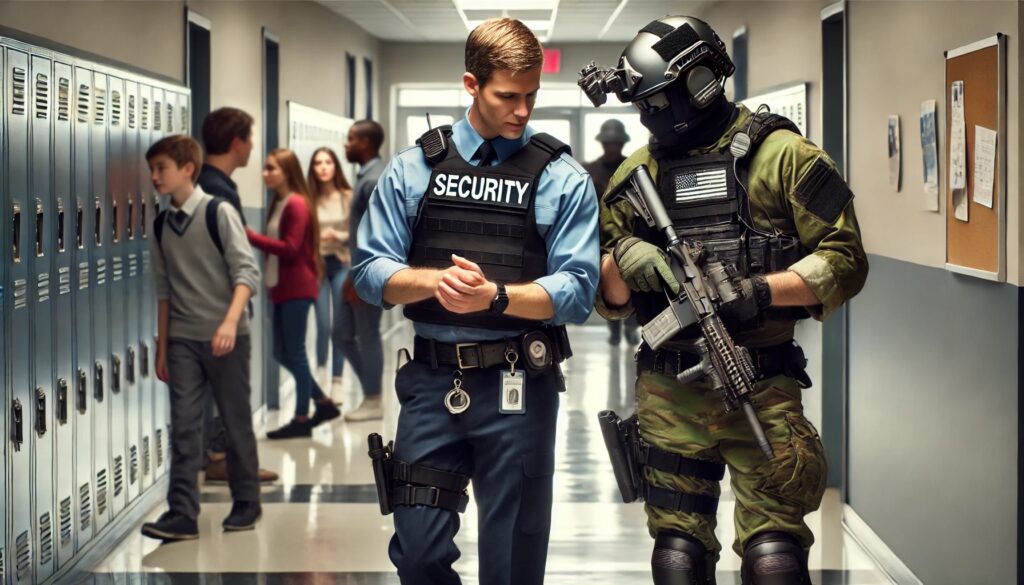
School security has become one of the most pressing concerns in education today. With the increasing prevalence of active shooter incidents, schools are investing heavily in security measures, such as armed guards, surveillance systems, and emergency response protocols. However, one critical aspect often overlooked is the development and implementation of a Deconfliction Policy to ensure the safety of school security personnel during an active shooter event.
Without a clear deconfliction strategy, the very measures designed to protect schools can inadvertently create new risks—especially during high-stress scenarios involving armed responders. This post will explore what deconfliction means, why it’s essential for school security, and how schools can integrate it into their active shooter response plans.
What is Deconfliction in School Security?
Deconfliction refers to the process of ensuring that multiple armed responders, including law enforcement and school security personnel, can effectively operate in the same space without mistaking each other for threats. In an active shooter situation, law enforcement officers arriving on the scene face immense pressure to identify and neutralize the shooter. If they encounter armed security guards who are not immediately recognizable as allies, there’s a risk of tragic, avoidable misunderstandings.
The Risks Without a Deconfliction Policy
When schools don’t have a deconfliction policy, they risk:
1. Misidentification of security personnel: Armed school guards without clear identifiers may be mistaken for the active shooter.
2. Communication breakdowns: In the chaos of an active shooter scenario, lack of coordination can lead to conflicting actions and delayed response times.
3. Loss of trust and coordination: Ongoing training and communication between school security and law enforcement build familiarity and confidence, which are absent without a deconfliction framework.
Essential Elements of a Deconfliction Policy
To address these risks, schools must develop and implement a deconfliction policy as part of their overall security strategy. Key components include:
1. Clear Identification for Security Personnel
School security guards should wear uniforms, badges, or other markings that make them easily identifiable to law enforcement officers. During emergencies, these identifiers must be visible and consistent to prevent misidentification.
2. Pre-Established Communication Protocols
Schools should establish direct communication channels between security personnel and local law enforcement. This includes shared radio frequencies or designated points of contact to ensure seamless information flow during an emergency.
3. Joint Training Exercises
Training isn’t just for school security teams—it’s for everyone involved in emergency response. Schools should conduct regular active shooter drills that include local law enforcement, school administrators, and security staff. Joint drills help build familiarity, improve coordination, and create a unified approach to crisis management.
4. Incident Command Structure
Clearly define roles and responsibilities for all parties involved in an active shooter response. This ensures that everyone understands their part in the deconfliction process, reducing confusion and delays.
Benefits of Deconfliction for School Security
A robust deconfliction policy isn’t just about avoiding tragedy—it’s about improving overall school safety. By implementing such policies, schools can:
• Minimize risks to security personnel and law enforcement officers.
• Streamline emergency response efforts.
• Build trust between school security teams and local police departments.
• Enhance the confidence of parents, staff, and students in the school’s safety measures.
Expert Perspectives on Deconfliction Policies
Industry experts like Matt Pasquinilli, a recognized leader in school security consulting, emphasize the importance of proactive measures like deconfliction. According to Pasquinilli, “A lack of coordination between school security and law enforcement can turn an already dangerous situation into a disaster. Deconfliction policies save lives by ensuring everyone is working together—not against each other—when seconds matter most.”
How Schools Can Get Started
If your school hasn’t yet addressed deconfliction, now is the time to act. Here are actionable steps to begin integrating these policies:
1. Conduct a security assessment with a professional consultant to identify gaps in your current emergency protocols.
2. Partner with local law enforcement agencies to establish communication protocols and identifiers for security personnel.
3. Schedule regular training sessions and drills that include all stakeholders.
4. Review and update your emergency response plans regularly to reflect changes in personnel, facilities, or local law enforcement procedures.
Conclusion
The safety of students and staff is the highest priority for schools, and effective deconfliction policies are a vital part of any comprehensive school security plan. By ensuring that school security personnel and law enforcement work together seamlessly during an active shooter scenario, schools can reduce risks and improve outcomes.
If your school is looking to strengthen its security measures, don’t overlook the importance of deconfliction. It’s not just a policy—it’s a lifesaving strategy.
For more insights on improving school security, reach out to experienced consultants like Matt Pasquinilli or your local law enforcement experts. Together, we can create safer schools for everyone.